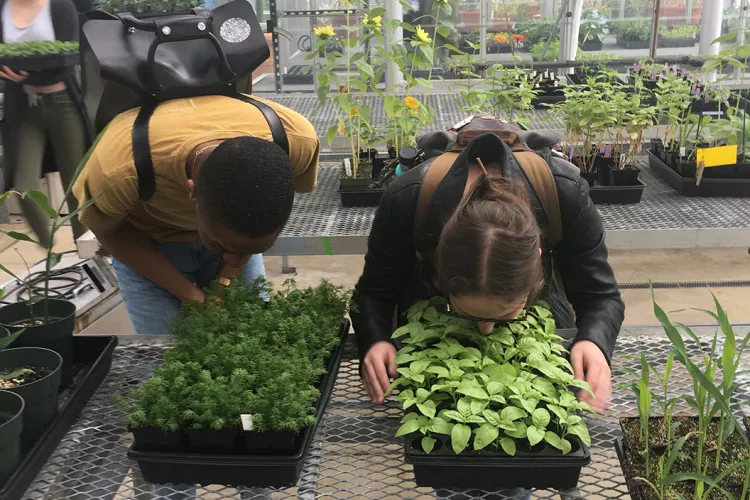‘Our Food’ Garden Connects Students and Community Members to Larger Food Systems

As spring progresses and classes come to an end, students are beginning to reap the benefits of their hard work. For 22 students in “Our Food”—a biology and environmental studies course with a garden as a lab component—these rewards are especially visible, as the crops they have been growing all semester begin to flourish.
The Our Food garden, located outside Sharples Dining Hall, serves as an experiential space for students where they can learn about plant development, soil biology, and the process of growing food. Each student chooses two crops to care for over the course of the semester. They then dedicate time each week to caring for their crops, from starting their seeds in Martin Greenhouse at the beginning of the semester to transplanting the sprouts to the garden when the weather warms.
For some students, the garden serves as a much-needed break from traditional academics.
“I like having homework that takes me outside of the library and is more hands-on,” says Sarah Solomon ’19, a psychology major from Rockville, Md. “Watching the slow progress of my plants grow and how hard it is to work the soil puts things in perspective.”
Yet students also stress the significance of gardening as a method for engaging with larger issues.
“My favorite part of the garden was the process of learning how to garden,” says Naja Smith ’20, a sociology & anthropology major from Gretna, La. “We had the power to choose the crops we wanted and were very integral to the survival and prosperity of them. I enjoyed the complexity and physical labor of growing crops, and it helped me relate, in some way, to the struggles farmers go through when producing crops for practically the whole country.”
Kayonna Tindle ’20, a classical studies major from Philadelphia, Pa., also reflected on how the garden serves as a small-scale example of the broader food system.
“Working in the Our Food garden [serves] as a physical reminder that food does not simply come from the market, but from farms that are owned and managed by farmers,” says Tindle.

Students first planted seeds in Martin Greenhouse before moving their sprouts to the garden outside Sharples.
The students’ empathy for the hard work of farmers reflects the larger goals of the Our Food course. Short for “Our Food System,” the course aims to teach students about the complexity of agricultural practices in the United States. Visiting Professor of Environmental Studies and Biology Jennifer Pfluger, who teaches Our Food, emphasizes how the garden is only one component of a much more nuanced and complicated food system.
“One irony is that what is grown in the garden does not actually represent ‘our food,’ since we eat diets rich in animal, wheat, corn, and soybean products,” Pfluger says. “This disconnect between public health and agriculture is one of the many social and environmental issues we analyze in the class.”
Through the garden’s location in a public space right outside Sharples, it also serves as a learning bridge between the students and community members.
“Most people who walk by slow down and take a moment—however brief—to look at what's happening,” says Pfluger. “When students are working in the garden, those moments often turn into whole conversations. I've often wished for a time-lapse photo series of this activity so others could see the behavioral transformations that fresh spaces can provide.”
As an educational demonstration garden, the harvested crops are distributed to students, staff, and faculty members throughout the summer through a partnership with Campus Engagement Coordinator Sue MacQueen of the Scott Arboretum. This year, community members can look forward to fresh vegetables, like kale and broccoli, and edible flowers, such as cornflower and Mexican tarragon. All crops are labeled and described with individual signs in the garden, so individuals can learn more about how their crops were grown.
Future hopes for the garden include adding seating and exhibition areas to transform it into a community gathering space. In the meantime, the garden continues to serve as a transformative space for students, who emphasize the power of getting their hands dirty as an empowering tool for changing the food system.
“Maintaining our crops throughout the past few months has been a uniquely fulfilling experience that deepened my appreciation, respect, and knowledge of agriculture,” says Mark Hergenroeder ’19, an economics and psychology major from Wormleysburg, Pa. “I feel a heightened sense of responsibility to spread this sentiment to others in my community.”
Swarthmore is investing in its vibrant intellectual culture. Learn how at lifechanging.swarthmore.edu.



